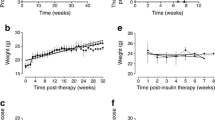Abstract
Quorum sensing signal molecules (QSSMs) from the bacterium Pseudomonas aeruginosa control bacterial population density and the expression of virulence determinants. Coincidentally, and possibly to allow this pathogen to gain a foothold in the human body, certain signal molecules also downregulate immunological responses in an apparently T-helper 1-selective manner, which would suggest their application as therapeutics to some autoimmune diseases. In the present paper, experiments are described that indicate that one particular signal molecule, a synthetic N-(3-oxododecanoyl)-L-homoserine lactone, can be used to alleviate insulitis and diabetes in non-obese diabetic (NOD) mice, suggesting that bacterial signal molecules may represent a novel source of immune modulatory compounds for the treatment of type 1 diabetes, which afflicts more than 2 million individuals in Europe and North America.
Similar content being viewed by others
Author information
Authors and Affiliations
Corresponding author
Rights and permissions
About this article
Cite this article
Pritchard, D.I., Todd, I., Brown, A. et al. Alleviation of insulitis and moderation of diabetes in NOD mice following treatment with a synthetic Pseudomonas aeruginosasignal molecule, N-(3-oxododecanoyl)-L-homoserine lactone. Acta Diabetol 42, 119–122 (2005). https://doi.org/10.1007/s00592-005-0190-2
Received:
Accepted:
Issue Date:
DOI: https://doi.org/10.1007/s00592-005-0190-2




